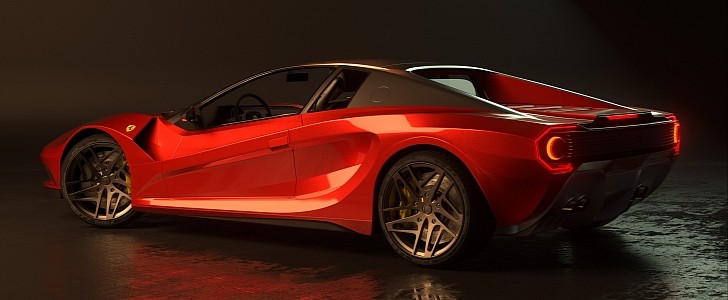Most people who do a modern reinterpretation of a classic model tend to take one, maybe two elements of the old-timer, wash them with a bit of contemporary soap, and then just paste them on a generic-looking present-day design.
While that approach can have sexy results, it tends to reduce the original model to little more than just a pretext to flex the artist's creative muscles while maintaining a minimal connection with the source material. It can be a little disrespectful to the classic car in question, what it stands for, as well as its designer, especially if any of the three holds an important spot in automotive history.
Well, like most other Ferrari models, the Testarossa pretty much ticks all the boxes. The ultra-wide model is one of the most easily recognizable cars of the '80s, and we don't think we'd be pushing it too far if we were to call it an automotive icon of the era. Its design was signed by Pininfarina—the studio, not the man himself—so it stacks up exceptionally well in that area, too, as it's one of the two Italian design houses that dominated the latter part of the 20th century, together with Giugiaro.
Paris-based designer and engineer Johann Delestree proposes an update for the 1984 model that takes it into the 21st century without messing with the vehicle's core elements. The proportions remain largely the same, and while the iconic fins on the side air intake are gone (which is probably the only complaint we have about this rendering), nine out of ten people would probably be able to identify this as a reinterpretation of the classic Testarossa.
The front end borrows the headlights from the LaFerrari hybrid hypercar, and since the pop-up units the original model had weren't an option anymore, it had to look for parts in the modern Ferrari lineup. The square angles of the 1980s sports care are mostly replaced by more curved surfaces, yet the grille in the bumper is a very clear throwback.
As we mentioned, the side profile is probably the angle that screams "Testarossa" the least, and that's because the blades on the vent are missing. The modern wheels Johann used also make it hard to think you're looking at a vehicle with historical roots, but then you get to the rear, and everything goes back to normal.
The original Ferrari Testarossa did not feature rounded taillights—in fact, it was so square, it probably wouldn't have featured rounded wheels if that was an option—and yet the black plastic band connecting them with the layered fins (Johann kept them here) is enough to identify the model as a Testarossa successor.
The complex air diffuser and the LED strips framing the taillights give it an obvious modern look. Even though the author doesn't talk in detail about the car's powertrain, it's obvious it still relies on burning gasoline to get the wheels turning. Not only are the quad tailpipes plain to see, but Johann even bothered to model the engine, though we can't quite tell how many cylinders it has. We'd be thoroughly disappointed if they were any fewer than 12, though.
Well, like most other Ferrari models, the Testarossa pretty much ticks all the boxes. The ultra-wide model is one of the most easily recognizable cars of the '80s, and we don't think we'd be pushing it too far if we were to call it an automotive icon of the era. Its design was signed by Pininfarina—the studio, not the man himself—so it stacks up exceptionally well in that area, too, as it's one of the two Italian design houses that dominated the latter part of the 20th century, together with Giugiaro.
Paris-based designer and engineer Johann Delestree proposes an update for the 1984 model that takes it into the 21st century without messing with the vehicle's core elements. The proportions remain largely the same, and while the iconic fins on the side air intake are gone (which is probably the only complaint we have about this rendering), nine out of ten people would probably be able to identify this as a reinterpretation of the classic Testarossa.
The front end borrows the headlights from the LaFerrari hybrid hypercar, and since the pop-up units the original model had weren't an option anymore, it had to look for parts in the modern Ferrari lineup. The square angles of the 1980s sports care are mostly replaced by more curved surfaces, yet the grille in the bumper is a very clear throwback.
As we mentioned, the side profile is probably the angle that screams "Testarossa" the least, and that's because the blades on the vent are missing. The modern wheels Johann used also make it hard to think you're looking at a vehicle with historical roots, but then you get to the rear, and everything goes back to normal.
The original Ferrari Testarossa did not feature rounded taillights—in fact, it was so square, it probably wouldn't have featured rounded wheels if that was an option—and yet the black plastic band connecting them with the layered fins (Johann kept them here) is enough to identify the model as a Testarossa successor.
The complex air diffuser and the LED strips framing the taillights give it an obvious modern look. Even though the author doesn't talk in detail about the car's powertrain, it's obvious it still relies on burning gasoline to get the wheels turning. Not only are the quad tailpipes plain to see, but Johann even bothered to model the engine, though we can't quite tell how many cylinders it has. We'd be thoroughly disappointed if they were any fewer than 12, though.












